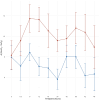Impact of mechanical power and positive end expiratory pressure on central vs. mixed oxygen and carbon dioxide related variables in a population of female piglets
- PMID: 38366303
- PMCID: PMC10873162
- DOI: 10.14814/phy2.15954
Impact of mechanical power and positive end expiratory pressure on central vs. mixed oxygen and carbon dioxide related variables in a population of female piglets
Abstract
Introduction: The use of the pulmonary artery catheter has decreased overtime; central venous blood gases are generally used in place of mixed venous samples. We want to evaluate the accuracy of oxygen and carbon dioxide related parameters from a central versus a mixed venous sample, and whether this difference is influenced by mechanical ventilation.
Materials and methods: We analyzed 78 healthy female piglets ventilated with different mechanical power.
Results: There was a significant difference in oxygen-derived parameters between samples taken from the central venous and mixed venous blood (S O2 = 74.6%, ScvO2 = 83%, p < 0.0001). Conversely, CO2-related parameters were similar, with strong correlation. Ventilation with higher mechanical power and PEEP increased the difference between oxygen saturations, (Δ[ScvO2-S O2 ] = 7.22% vs. 10.0% respectively in the low and high MP groups, p = 0.020); carbon dioxide-related parameters remained unchanged (p = 0.344).
Conclusions: The venous oxygen saturation (central or mixed) may be influenced by the effects of mechanical ventilation. Therefore, central venous data should be interpreted with more caution when using higher mechanical power. On the contrary, carbon dioxide-derived parameters are more stable and similar between the two sampling sites, independently of mechanical power or positive end expiratory pressures.
Keywords: ARDS; ScvO2; SvO2; carbon dioxide; central versus mixed gap; intrathoracic pressures; mechanical power; oxygen saturation; septic shock.
© 2024 The Authors. Physiological Reports published by Wiley Periodicals LLC on behalf of The Physiological Society and the American Physiological Society.
Conflict of interest statement
The Authors declare no conflicts of interest.
Figures




Similar articles
-
[Research progress of diagnostic and therapeutic value of carbon dioxide-derived indicators in patients with sepsis].Zhonghua Wei Zhong Bing Ji Jiu Yi Xue. 2024 Apr;36(4):435-440. doi: 10.3760/cma.j.cn121430-20240122-00074. Zhonghua Wei Zhong Bing Ji Jiu Yi Xue. 2024. PMID: 38813642 Review. Chinese.
-
Combining central venous-to-arterial partial pressure of carbon dioxide difference and central venous oxygen saturation to guide resuscitation in septic shock.J Crit Care. 2013 Dec;28(6):1110.e1-5. doi: 10.1016/j.jcrc.2013.07.049. J Crit Care. 2013. PMID: 24216336
-
Effects of time delay and body temperature on measurements of central venous oxygen saturation, venous-arterial blood carbon dioxide partial pressures difference, venous-arterial blood carbon dioxide partial pressures difference/arterial-venous oxygen difference ratio and lactate.BMC Anesthesiol. 2018 Dec 11;18(1):187. doi: 10.1186/s12871-018-0655-9. BMC Anesthesiol. 2018. PMID: 30537939 Free PMC article.
-
The Prognostic Value of Central Venous-to-Arterial CO2 Difference/Arterial-Central Venous O2 Difference Ratio in Septic Shock Patients with Central Venous O2 Saturation ≥80.Shock. 2017 Nov;48(5):551-557. doi: 10.1097/SHK.0000000000000893. Shock. 2017. PMID: 28492385
-
Use of venous-to-arterial carbon dioxide tension difference to guide resuscitation therapy in septic shock.World J Crit Care Med. 2016 Feb 4;5(1):47-56. doi: 10.5492/wjccm.v5.i1.47. eCollection 2016 Feb 4. World J Crit Care Med. 2016. PMID: 26855893 Free PMC article. Review.
Cited by
-
Recent advances in cardiorespiratory monitoring in acute respiratory distress syndrome patients.J Intensive Care. 2024 May 5;12(1):17. doi: 10.1186/s40560-024-00727-1. J Intensive Care. 2024. PMID: 38706001 Free PMC article. Review.
References
-
- Andrew, L. (2000a). Carbon dioxide. In Nunn J. F. (Ed.),Nunn's Apllied Respiratory Physiology (pp. 222–232).
-
- Andrew, L. (2000b). Diffusion of respiratory gases. In In Nunn J. F. (Ed.), Nunn's Applied Respiratory Physiology (pp. 208–209).
MeSH terms
Substances
LinkOut - more resources
Full Text Sources
Miscellaneous

